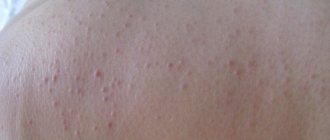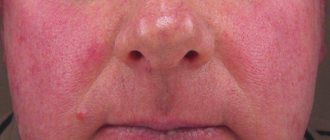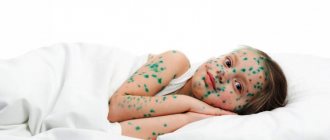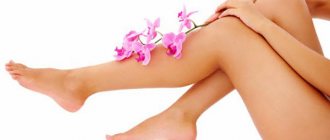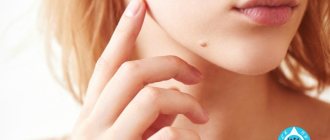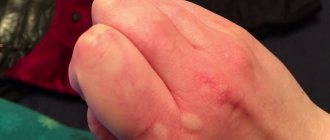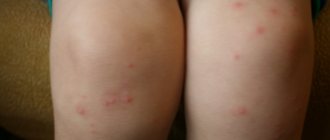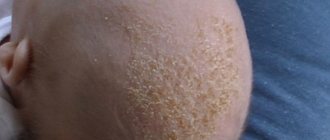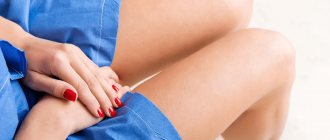H1 CC
Skip to content
- cosmetologist
- Contacts
Home » Health » Fighting acne and acne
Healthy and clean skin on your hands gives you confidence and makes you feel attractive. However, no person is immune from the appearance of a skin rash. To cure acne on the arms and legs, you will need to put in a lot of effort, but an integrated approach can provide a positive result.
Short description
Any allergy occurs as a result of abnormal susceptibility of the immune system to various provocateurs. As a result, the body produces not immunoglobulin, but antigens. They lead to the appearance of high concentrations of histamine and are the source of inflammatory mediators that cause characteristic symptoms.
Allergies on the arms and legs are of a skin nature. It can vary in speed of manifestation. Sometimes the body immediately reacts to the allergen (atopic dermatitis, urticaria). Signs of pathology can appear within a few minutes or a couple of hours after contact with the provocateur.
In other cases, there is a rather slow development of symptoms (contact dermatitis). Such an allergy on the legs will make itself felt within a day, and sometimes after a longer period.
The nature of external manifestations of COVID-19
Dresden scientists from the Department of Dermatology and Allergology of the State Clinic published an article about the problems of treating coronavirus disease related to their specialization.
The publication describes a large amount of information about the skin symptoms of patients, although at the moment their specificity for COVID-19 has not yet been proven. At the same time, Dresden scientists emphasize that during the pandemic it has become extremely difficult to treat patients with inflammatory pathologies, for example, psoriasis.
“Although COVID-19 is not a skin disease, its impact on dermatology is significant,” the scientists said in the published paper.
Russian virology experts confirm the same, explaining the occurrence of skin reactions by the following mechanism: “With coronavirus infection, in some cases there is overexpression of anti-inflammatory cytokines (soluble proteins that transmit signals between cells), which causes an imbalance in the inflammatory response of the immune system. This can provoke the appearance of various rashes on human skin.”
At the same time, scientists argue that this mechanism is only one of the possible ways leading to the appearance of a rash. There are, in all likelihood, many reasons for its occurrence, so they will need to be studied more carefully and in depth.
Reasons for appearance
Allergies to the arms and legs can occur under the influence of exogenous (external) factors and endogenous (internal) sources. Let's look at them in more detail.
External causes of allergies are:
- Mechanical impact. This is a certain load on the skin, in the form of friction, compression, and prolonged vibration. For example, foot allergies often appear as a result of wearing tight shoes or tight trousers. During long walking they cause skin irritation. Extremely unpleasant symptoms of the pathology appear on the integument.
- Contact with household chemicals, plants and other provocateurs.
- Wearing synthetic clothing that does not provide normal air access to the body.
- Hypothermia, low temperatures.
- Insect bites, animal fur.
- Excessive skin exposure to sunlight.
Internal causes affect the body through disruption of metabolic processes and the circulatory system.
Endogenous sources of the disease are:
- Food allergens. They can cause a rash on any part of the body.
- Certain pathologies. Allergic dermatitis can develop against the background of varicose veins and diabetes. With such pathologies, negative symptoms occur only on the legs.
The following factors most often provoke attacks of an allergic reaction:
- lack of treatment for underlying ailments;
- failure to comply with hygiene rules.
Types of allergies
Pathology on the skin of the hands and feet can manifest itself as the following characteristic lesions:
- Hives. With this pathology, blisters of various sizes appear. Such symptoms are most often provoked by direct contact of this area with an external allergen.
- Rash. Small red swellings are visible on the integument. They can be of various shapes. In some cases, such rashes merge with each other. This is a fairly common foot allergy. Red spots formed by the coalescence of small rashes can reach impressive sizes. As a rule, this type of pathology appears after direct contact with a provocateur. The source of the rash can be the penetration of an allergen into the body with food or through the respiratory system.
- Dermatitis. Inflammatory lesions of various types are observed on the skin. Most often they occur as a result of prolonged exposure and high levels of allergen.
- Reaction to cold. If the body is highly sensitive to low temperatures, then under the influence of negative factors red spots appear on the skin.
- Allergy to fungus. Most often, the lesion affects the fingers and feet.
Allergy is a chronic disease. But it only intensifies under the influence of provocateurs.
Treatment tactics for rashes on the palms and soles
Since the causes of the rash are different, symptomatic therapy is most often practiced. Preference is given to topical medications, but sometimes specialists prescribe oral medications or a course of injections. In rare cases, radical treatment is required, which involves eliminating the disease that caused the skin manifestations.
- Affected skin areas should be protected from the irritating effects of hygiene products and household chemicals. During the period of relapse of the disease, you should stop using shower gels and soaps, and use gloves for housework.
- Do not wear synthetic, wool or fur products on the affected parts of the body. It is necessary to temporarily exclude from the diet foods that most often cause allergic reactions.
A complex form of contact dermatitis involves the external use of hormonal or antihistamines in combination with oral medications. In severe cases of pathology, potent medications are prescribed. Weak agents are used externally first, and then more potent creams and ointments.
Treatment of the disease is completed with drugs with minimally pronounced effect. A cream is usually prescribed to dry wet areas, and ointment is prescribed to moisturize affected areas with cracks.
Hormonal ointments are applied to the skin for 1-2 weeks.
Treatment with such drugs is fraught with various side effects. Non-hormonal drugs can be used for a long time. To combat dyshidrosis, various anti-inflammatory and antihistamines are used, and in advanced cases, medications and ointments with a hormonal component. In addition, diuretics and hemodez are prescribed (to prevent the development of side effects of glucocorticosteroids).
Small lesions at an early stage of the disease are eliminated with ointments with naftalan oil, birch tar and sulfur. In the presence of a secondary infection, including fungal infection, fucorcin is used. When dyshidrosis is non-infectious, Advantan ointment is used.
If the rash is infectious, parasitic or viral in origin, then the main goal of treatment should be to combat the causative agent of the disease. In this case, the treatment regimen is prescribed by the doctor. For lichen and other fungal diseases, the following are usually recommended:
- Fukortsin solution,
- creams and sprays "Lamisil", "Lamicon".
To combat scabies, antiparasitic ointments (“Benzyl benzoate”) are most often prescribed. Bacterial skin lesions require the use of antibacterial ointments.
Rashes on the palms and soles appear for various reasons. Treatment medications must be prescribed by a doctor. In addition to medications, physical therapy can be used, for example, acupuncture, electrosleep, ultraviolet irradiation, etc.
We recommend:
Peeling toes - reasons;Small red rash - causes;
Red spots on the back - .
Characteristic symptoms on the legs
Allergies on the feet in adults most often occur in the following places:
- on the hips;
- feet;
- shins.
After direct contact with the causative agent of the disease has occurred, the disease will make itself felt, usually within an hour.
The development of an allergic reaction is initially indicated by the following signs:
- reddened areas appear on the skin;
- the skin becomes dry;
- the dermis begins to peel off;
- this can all be accompanied by severe itching.
If you ignore the initial symptoms, other signs of the disease will soon appear. It will be much more difficult to get rid of them.
The next stage of development is characterized by the following manifestations:
- Stains. They can be point, relief, towering. It is quite difficult to say regarding color and shade. The spots can be either bright red or pale pink. It depends on how the body reacts to the allergen.
- Pimples. Often, allergies on the skin of the feet manifest themselves in the form of small rashes. Pimples can fill with purulent contents. Subsequently, crusts form at the site of such manifestations.
- Edema. Sometimes this is how allergies manifest themselves. Some people believe that swelling occurs after walking for a long time. But this is a characteristic symptom of an allergy. Edema manifests itself as a dense swelling of certain areas. It is usually completely painless.
- Itching. This is one of the characteristic signs of allergies. It causes excruciating discomfort in a person. This symptom often appears long before the rash appears. Itching can be chronic or acute. It can be localized to a specific area or cover almost the entire body.
Allergy symptoms on hands
The signs that manifest the disease in the upper extremities are similar to those described above.
Pathology on the hands, as well as allergies on the feet, is characterized by the following symptoms:
- redness of the skin;
- burning, itching;
- peeling, dryness;
- rashes: papules, blisters, blisters;
- swelling.
Sometimes such manifestations are accompanied by general signs of the disease:
- redness of the eyes, tearing;
- chills;
- disorders in the digestive tract: vomiting, diarrhea;
- pale skin;
- dry cough;
- nasal congestion;
- sore throat;
- decreased blood pressure;
- temperature increase;
- dizziness;
- swelling of the eyelids and face.
Where is it more common and on what day do rashes appear due to coronavirus infection?
Analysis of the situation allowed doctors to identify typical locations of coronavirus rashes.
Belly, back, chest
The most common localization of rashes with COVID-19 is on the anterior surface of the body: chest, abdomen. Less commonly, the rash appears on the back. The primary element of the rash is a vesicle filled with serous or mixed with pus and blood contents, in second place are nodules. Any rash is accompanied by itching. There is a virus inside the bubbles.
Limbs
Rashes due to coronavirus infection affect the feet, and changes in the toes can even be attributed to specific manifestations of the virus - covid toes. They resemble frostbite with a bluish tint and necrosis of the nails. But despite the apparent severity of the manifestations, the symptoms are reversible and disappear without a trace after recovery. On the hands the picture is similar, but occurs less frequently.
Head, face
During coronavirus, these zones are not independently involved in the pathological process. But the rash can spread from the chest to the neck, scalp, forehead and cheeks.
Mouth, nasopharynx
It is surprising that despite the infection of the nasopharynx by the virus, there is never a rash in it. Apparently, defense mechanisms are triggered, forcing the virus to move on.
Children's allergies
Babies are also not immune to unpleasant symptoms. Allergies in a child’s legs or arms can occur for many reasons.
The most common sources are:
- A new product that has been introduced into the diet.
- Clothes made from poor quality fabric.
- Powder used to wash children's clothes.
In children, allergies are expressed as:
- red spots that can merge with each other.
- itching (babies become whiny, irritable, and have trouble sleeping).
Diagnostics
To make a diagnosis, it is necessary to undergo a thorough examination.
- Laboratory tests - general blood test and biochemical analysis of plasma with kidney samples.
- Blood test for sugar.
- Collection of biomaterial (epidermis) for bacteriological seeding.
- Scraping from affected tissue to identify fungal infections.
- Instrumental examination of the venous bed for the presence of blood clots - venography.
Scraping the affected area of skin will help determine the presence of concomitant infections.
Help a child
The main thing is not to panic. Calmly assess the situation and do not self-medicate. Contact your pediatrician. If your child has a fever and the rash spreads throughout the body, call an ambulance.
While the specialists arrive, parents can do the following:
- If you know what caused the negative reaction, then immediately limit contact with the allergen. If the symptoms are provoked by contact (clothing, animal hair, household chemicals), then immediately take off your clothes and wash the baby well with baby soap.
- If an allergen gets inside the body, it is necessary to give the baby a sorbent. It will absorb part of the allergen, thereby reducing its concentration. The following sorbents are suitable for children: “Smecta”, “Atoxil”, “White Coal”, “Polysorb”, “Enterosgel”.
- The child needs a lot of fluids. It is best to give black tea or water.
- Maintain a normal temperature in the room (about 22-23 C). This will protect against excessive sweating.
- If the allergy is triggered by a food product, then it is likely that the baby will experience constipation. This is a rather dangerous condition for this pathology. After all, allergens, along with toxins, begin to be perfectly absorbed into the blood. For constipation, it is recommended to give one of the following drugs: “Dufalak”, “Normaze”, “Normolakt”.
- The antiallergic drug can be given to the baby only 30 minutes after the sorbent. Effective remedies are considered to be: “Zyrtec”, “Erius”, “Zodak”, “Fenistil”. It is best to hold off on these medications and wait for a pediatrician’s consultation.
Treatment of pathology in adults with hormonal agents
If the allergy on your leg itches and constantly causes discomfort, then ointments with antihistamine and anti-inflammatory effects will bring significant help. Of course, such medications should be prescribed by a doctor. Hormonal ointments are prescribed only in case of severe exacerbations.
Excellent tools are:
- "Triamcinolone".
- "Fluticasone."
- "Dexamethasone."
- "Hydrocortisone."
- "Methylprednisolone."
- "Advantan".
- "Elokom".
Non-hormonal ointments
Such remedies are considered more gentle therapy.
The following ointments are in demand in the fight against the disease:
- Antiseptics. The following drugs are effective: “Dioxidin”, “Bepanten”, furacilin and dermatol ointments.
- Antibiotic medications. The following drugs may be prescribed: Levomekol, Erythromycin.
- Antihistamines. The following will be beneficial: “Ichthyol ointment”, “Fenistil-gel”, “Tsindol”, zinc ointment, “Elidel”.
- Regenerative medicines. The following products provide excellent tissue regeneration and have a healing effect: methyluracil and solcoseryl ointment. The following drugs will be beneficial: Actovegin, Bepanten.
- Emollient medications. Medications may be included in therapy: Videstim, Keratolan.
Preparations for internal use
It is best for a doctor to prescribe medications. The doctor is able to adequately assess at what stage the allergy occurs.
Rash on the legs, red spots, itching are external manifestations that can be effectively eliminated with the help of local medications. Provided that contact with the provocateur is excluded. But if such symptoms do not go away, then the doctor will recommend medications for internal use.
The following drugs may be included in therapy:
- "Suprastin", "Diazolin", "Tavegil", "Diphenhydramine", "Fenistil".
- Loratadine, Claridol, Zyrtec.
- “Zodak”, “Astemizole”, “Trexil”, “Acrivastin”.
These medications have some contraindications. Therefore, it is not advisable to take them without consulting a doctor.
Which doctor should I contact?
If a spot appears on your leg, you should immediately consult a doctor. The doctor will help you figure out why it formed and what to do about it. A dermatologist deals with changes in the skin. The specialist analyzes the patient’s complaints and examines the affected areas. If necessary, prescribe examination by other highly specialized doctors:
If red spots appear on your legs, consult a dermatologist
Consultation with several specialists allows you to accurately determine the cause of the appearance of red spots and select effective therapy.
